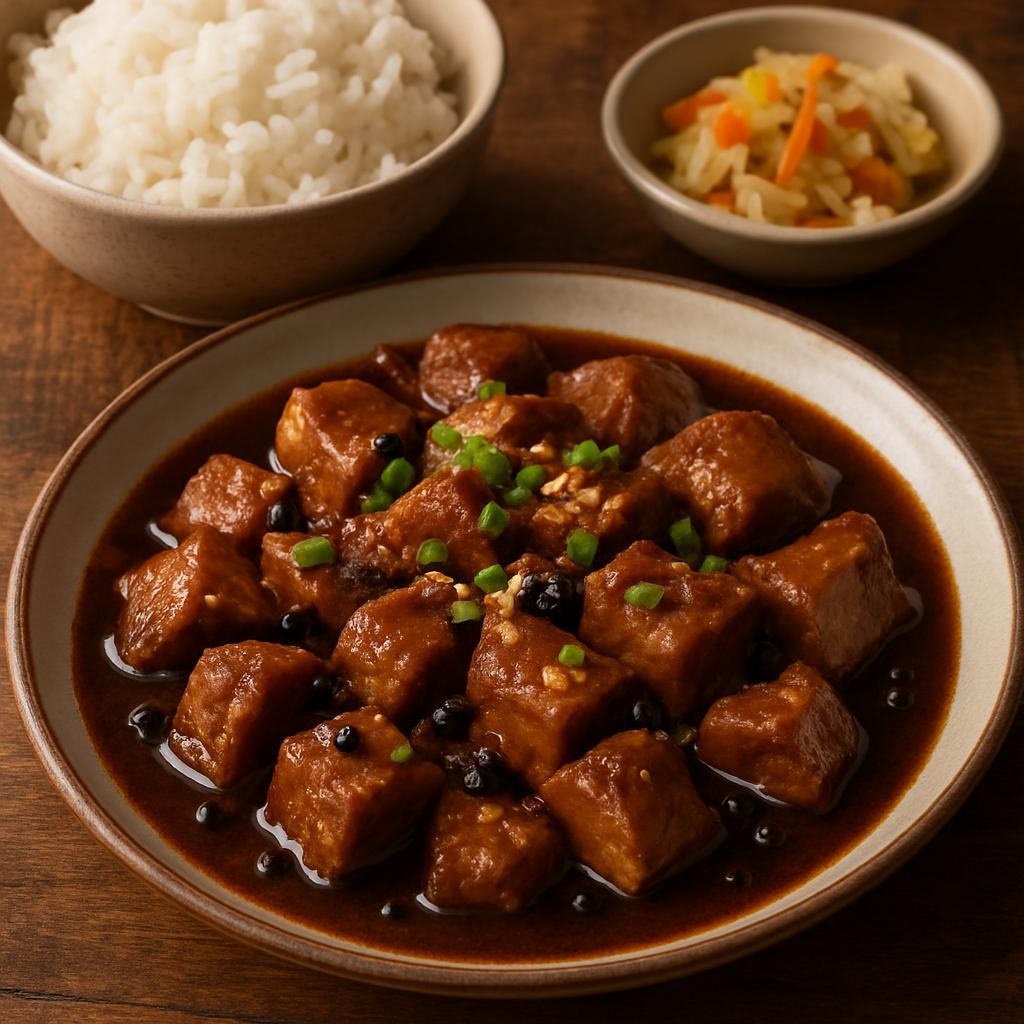Pork Adobo (Adobong Baboy) is a classic Filipino dish that brings together tender pork marinated in a savory mix of soy sauce, vinegar, garlic, bay leaves, and peppercorns. This dish is beloved for its rich, tangy flavor and melt-in-your-mouth texture, making it a staple in many Filipino households. The beauty of Pork Adobo lies not only in its taste but also in its simplicity, making it a perfect option for both everyday meals and special occasions.

Why You Will Love This Recipe
You will absolutely love this Pork Adobo recipe for its bold flavors and straightforward cooking process. The combination of soy sauce and vinegar creates a perfect balance of salty and tangy, complementing the richness of the pork. It’s an one-pot meal that requires minimal effort, allowing the ingredients to meld beautifully as they simmer. Whether you’re a busy professional, a cooking novice, or just someone looking to enjoy a comforting dish, Pork Adobo fits perfectly into any lifestyle. Plus, it’s a crowd-pleaser that brings a taste of the Philippines right to your dining table.
Tips and Tricks
To make your Pork Adobo even more delicious, consider these tips and tricks:
- Marinate Longer: If you have time, marinating the pork overnight will enhance the flavors even more.
- Use Different Cuts: While pork belly is traditional, feel free to use pork shoulder or pork butt for a leaner option.
- Adjust the Vinegar: If you prefer a milder taste, you can reduce the vinegar slightly or add a touch of sugar to balance the acidity.
- Add Vegetables: For extra nutrition, throw in some potatoes or hard-boiled eggs during the last 30 minutes of cooking.
Make Ahead Tips
Pork Adobo is a great dish to make ahead of time. You can marinate the pork a day in advance to let the flavors develop. The cooked adobo also stores well; in fact, it often tastes even better the next day! Store it in an airtight container in the refrigerator for up to 3 days. You can also freeze it for up to a month; just make sure to cool it completely before transferring it to a freezer-safe container.

Recipe Variations
To switch things up, consider these variations:
- Coconut Adobo: Add coconut milk for a creamy twist on the traditional recipe.
- Spicy Adobo: Include chili peppers or a dash of hot sauce for a spicy kick.
- Vegetarian Option: Swap pork with tofu or seitan for a plant-based version.
- Adobo sa Miso: Incorporate miso paste for a deeper umami flavor.
How to Serve
Serve Pork Adobo hot, garnished with freshly chopped green onions or fried garlic for an extra touch of flavor. Pair it with steamed white rice to soak up the delicious sauce, and consider adding a side of pickled vegetables to balance the richness of the dish. For an authentic touch, you can also serve it in a traditional Filipino-style bowl.

Pairing Suggestions
For drinks, a cold San Miguel beer or a refreshing iced tea complements the savory notes of Pork Adobo beautifully. If you prefer wine, a light-bodied red like Pinot Noir or a chilled Riesling works well. As for sides, consider serving it with a simple green salad or some fried plantains for an added crunch. For dessert, a slice of leche flan or a bowl of halo-halo would round off the meal perfectly.
How to Store
To store leftovers, place them in an airtight container and refrigerate for up to 3 days. If you wish to freeze the adobo, ensure it’s cooled completely before placing it in a freezer-safe container. It can last up to a month in the freezer. When ready to eat, thaw it overnight in the refrigerator and reheat gently on the stove over low heat until warmed through.
Equipment Needed
You will need a large pot or Dutch oven for cooking the adobo. A heavy-bottomed pot helps distribute heat evenly, which is crucial for even cooking. If you don’t have a Dutch oven, a regular pot will work just fine. A cutting board and sharp knife are also essential for prepping the ingredients.

Dietary Adaptations
For those with dietary restrictions, here are some adaptations:
- Gluten-Free: Use tamari or coconut aminos instead of regular soy sauce.
- Vegan: Substitute the pork with firm tofu or jackfruit, ensuring the cooking time is adjusted accordingly.
- Paleo: Use coconut aminos and omit any added sugars.
- Nut-Free: This recipe is naturally nut-free, making it safe for those with nut allergies.
Seasonal Adaptations
Adjust your ingredients based on seasonality. In the summer, you might find fresh herbs and vegetables to add, such as bell peppers or green beans. During the fall, consider adding root vegetables like carrots or sweet potatoes for a heartier dish. Fresh garlic and onions are available year-round, but using locally sourced produce enhances the dish’s flavor and sustainability.
Recipe FAQs
Can I use chicken instead of pork? Yes, you can make Chicken Adobo using the same method, just adjust the cooking time as chicken cooks faster than pork.
How long should I marinate the pork? Ideally, marinate for at least 30 minutes, but overnight is best for maximum flavor.
What if I don’t have bay leaves? While bay leaves add a distinct flavor, you can omit them if necessary. Thyme or oregano can be used as substitutes.
Can I cook this in a slow cooker? Absolutely! Just add all the ingredients to your slow cooker and cook on low for 6-8 hours.
Pork Adobo (Adobong Baboy)

Pork Adobo (Adobong Baboy) is a classic Filipino dish that brings together tender pork marinated in a savory mix of soy sauce, vinegar, garlic, bay leaves, and peppercorns.
Ingredients
- 2 lbs pork belly or pork shoulder, cut into chunks
- 1 cup soy sauce
- 1/2 cup vinegar (white or cane vinegar)
- 1 head garlic, minced
- 2-3 bay leaves
- 1 teaspoon whole black peppercorns
- 1 tablespoon vegetable oil
- 1 cup water
- Salt to taste
- Optional: 1-2 tablespoons sugar for sweetness
Instructions
- In a bowl, combine the pork, soy sauce, vinegar, garlic, bay leaves, and peppercorns.
- Mix well and let it marinate for at least 30 minutes, preferably overnight in the refrigerator.
- Heat the vegetable oil in a large pot over medium heat. Remove the pork from the marinade (reserve the marinade) and sear the pork until browned on all sides.
- Pour the reserved marinade and water into the pot. Bring to a boil, then reduce to a simmer.
- Cover the pot and let it cook for about 1 to 1.5 hours, or until the pork is tender. Stir occasionally, and add more water if necessary to prevent burning.
- Once tender, taste and adjust the seasoning with salt or sugar if desired. Simmer uncovered for an additional 10-15 minutes to thicken the sauce.
- Serve hot with steamed rice.
Nutrition Information:
Yield: 6 Serving Size: 1Amount Per Serving: Calories: 578Total Fat: 40gSaturated Fat: 14gTrans Fat: 0gUnsaturated Fat: 24gCholesterol: 147mgSodium: 2592mgCarbohydrates: 8gFiber: 1gSugar: 4gProtein: 44g
Asianplated.com, occasionally offers nutritional information for recipes contained on this site. This information is provided as a courtesy and is an estimate only. This information comes from online calculators. Although allchickenrecipes.com attempts to provide accurate nutritional information, these figures are only estimates.
Final Thoughts
Pork Adobo is a dish that encapsulates the heart of Filipino cuisine with its robust flavors and comforting nature. It’s a recipe that is not only easy to prepare but also offers endless possibilities for customization. Whether you’re sharing it at a family gathering or enjoying it on a quiet evening at home, Pork Adobo is sure to bring joy to your table. So gather your ingredients and experience the delightful flavors of this beloved dish!
